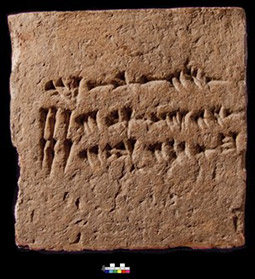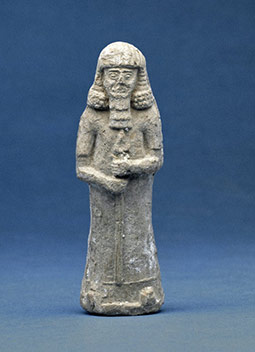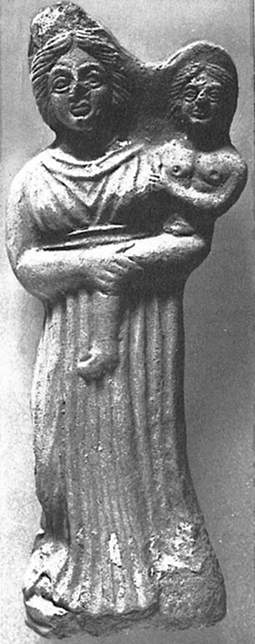Kalhu from the 7th century to the post-Assyrian period
At the end of the 8th century BC, Sargon II PGP (r. 721-705 BC) moved the seat of royal power from Kalhu to his recently completed new capital, Dur-Šarruken (modern Khorsabad PGP ). Although Dur-Šarruken was abandoned by the court after Sargon's death, Kalhu never regained its capital status. Nevertheless, it continued to serve as provincial TT capital and an important centre of learning until the very end of the Assyrian empire, and was occupied into the Hellenistic TT period and beyond.
Kalhu in the 7th century BC

Image 1: The inscription on this brick begins, "The palace of Esarhaddon PGP , king of Assyria", showing clearly that he intended to reside there, at least some of the time. BM 90248. View large image on British Museum website. © The Trustees of the British Museum.
After the ominous death of Sargon II PGP on a battlefield in Anatolia PGP - where his body was lost forever - his son Sennacherib PGP made the decision to move his court away from Dur-Šarruken and its ill-fated associations. He didn't, however, return to Kalhu, which had served as the Assyrian royal capital since the reign of Assurnasirpal II (r. 883-859 BC). Instead, Sennacherib chose the ancient city of Nineveh PGP (modern Mosul PGP ) and renovated it extensively. As a result, Kalhu was no longer the administrative centre of the empire, but it remained one of Assyria's key cities. As the seat of the governor TT of the province of Kalhu, it must have continued to house local administration, even though such records from the 7th century have not been found.
The city had for some time represented an important centre of scholarship, and this role continued into the 7th century. It was home to many prominent scholars TT , some of whom acted as senior advisors to the Assyrian king. The temple of Nabu housed an impressive collection of literary and scholarly materials which were used by the king and his scholars to aid his decision-making and guide his relationship with the gods. Even after the court moved permanently to Nineveh, many of these men, such as Nabu-zuqup-kena, spent at least some of their time in Kalhu. This is clear for instance from the colophons TT (scribal postscripts) of many cuneiform TT tablets TT , which record Kalhu as the place where they were written.

Image 2: A clay figurine TT in the shape of a protective lahmu TT spirit. Found at Fort Shalmaneser, the figure was used during the reigns of Esarhaddon PGP and Sin-šarru-iškun PGP , both of whom carried out building work at Kalhu. BM 140435. View large image on British Museum website. © The Trustees of the British Museum.
In addition, the city of Kalhu was the location of important state documents, including perhaps the Succession Treaties of king Esarhaddon (r. 680-669 BC). These documents record a series of loyalty oaths in which Assyria's vassals TT swore to uphold Esarhaddon's succession TT plans. The treaties were destroyed by looters in Nabu's temple in 612 BC, but it is unclear whether they were originally stored there. However, the temple was certainly used to safeguard the three seals of the god Aššur which were impressed TT on to the treaties alongside the seal TT of the king - a sign of Ezida's continued importance in the 7th century.
A royal capital once more?
Much of the building activity now naturally focused on Nineveh, particularly during the reign of Sennacherib who carried out no new work at Kalhu. His son and successor Esarhaddon, however, took a great deal of interest in the city. Around 672 BC, towards the end of his reign, he rebuilt part of the city wall and made significant improvements to Fort Shalmaneser. He added a new terrace and created an impressive new entrance consisting of a vaulted ramp which led from a newly-rebuilt postern gate TT directly into the palace through a series of painted rooms. Inscriptions on both sides of the gate commemorated this construction work, as did clay cylinders which were perhaps originally deposited inside Fort Shalmaneser's walls (Image 1).
It is possible that Esarhaddon's activities at Kalhu were intended as a prelude to reclaiming it as royal capital. There is some, albeit very limited evidence, that he may have lived at Kalhu briefly towards the end of his reign: a partially preserved letter mentions that the king's courtiers "are all in Kalhu", perhaps indicating that the court had moved there from Nineveh (SAA 13: 152). While Esarhaddon's successors made their home at Nineveh, some at least continued to carry out building repairs at Kalhu. The last king to do so was Sin-šarru-iškun PGP (r. 624-612 BC). His reconstruction of the temple of Nabu was violently undone when the city was sacked and most of its buildings put to the torch by Median PGP invaders in 614 BC, and again two years later.

Image 3: Terracotta figurine in the Hellenistic TT style, showing mother and child. It was found in a pit cut into the wall of the temple of Nabu, and probably dates from the early 2nd century BC. ND 5202 (1). View large image. Photo: Iraq Museum.
Kalhu in the post-Assyrian period
The fall of the Assyrian empire at the end of the 7th century BC represented a major historical and political break, but in some ways life in Assyria continued as before. After the city's destruction, the locals returned to make their home among the ruins of the citadel TT mound and Fort Shalmaneser, presumably because their walls offered a degree of protection. However, archaeological evidence shows that living in the city was far from safe: the Medes' first attack in 614 BC was followed by another in 612, and there is evidence that the occupants of post-Assyrian Kalhu suffered further destruction from unknown attackers on several occasions. The "squatter occupation" of the city's monumental ruins probably did not last long, as the material remains from this period, such as pottery, look no different from those of the late Assyrian period - clearly, they were not in use long enough for changes to appear.
However, this did not spell the end of the city. There is some evidence of occupation and rebuilding during the Neo-Babylonian TT and Achaemenid TT periods in the 6th to 4th centuries, but unfortunately no written sources have survived to help us understand what was going on in Kalhu at this time. In 401 BC the Greek soldier and historian Xenophon PGP passed by the city (which he calls Larissa) and reported that it was all but deserted, with only the dilapidated ziggurat providing refuge to the local people (Anabasis III:4).
By far the most extensive remains come from the Hellenistic TT period, when a succession of small settlements sprung up in the citadel area. The village was destroyed in a fire but its inhabitants left behind coins, pottery and numerous other small finds (Image 3). These have enabled the excavators to date the village community to c.250-140 BC, and to build up a detailed picture of daily life in Hellenistic Assyria. We know, for example, that members of this community lived in small houses whose rooms were arranged around a small courtyard - much like the palaces on whose ruins they stood. And the ovens in which the villagers baked their bread resemble the ovens which are still used today, more than two millennia later.
Content last modified: 18 Dec 2019.
References
- Oates, D. and J. Oates, 2001. Nimrud, An Assyrian Imperial City Revealed, London: British School of Archaeology in Iraq ( free PDF from BISI, 128 MB), pp. 265, Fig. 170. (Find in text ^)
Further reading
- Oates, D. and J. Oates, 2001. Nimrud, An Assyrian Imperial City Revealed, London: British School of Archaeology in Iraq ( free PDF from BISI, 128 MB).
- Postgate, J.N. and J.E. Reade, 1976-1980. "Kalhu", Reallexikon der Assyriologie und Vorderasiatischen Archäologie 5, Berlin: Walter de Gruyter, pp. 303-323.
- Reade, J.E., 1982. "Nimrud", in J.E. Curtis (ed.), Fifty Years of Mesopotamian Discovery: The Work of the British School of Archaeology in Iraq, 1932-1982, London: British School of Archaeology in Iraq, pp. 99-112 (free PDF from BISI, 131 MB).
Silvie Zamazalová
Silvie Zamazalová, 'Kalhu from the 7th century to the post-Assyrian period', Nimrud: Materialities of Assyrian Knowledge Production, The Nimrud Project at Oracc.org, 2019 [http://oracc.museum.upenn.edu/nimrud/ancientkalhu/thecity/latekalhu/]